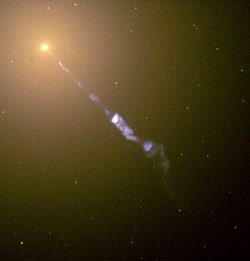This article needs additional citations for verification .(March 2014) |
This article needs attention from an expert in physics. The specific problem is: to provide an accessible overview of the physics and the governing equations.(November 2024) |


In physics, relativistic beaming (also known as Doppler beaming, Doppler boosting, or the headlight effect) is the process by which relativistic effects modify the apparent luminosity of emitting matter that is moving at speeds close to the speed of light. In an astronomical context, relativistic beaming commonly occurs in two oppositely directed relativistic jets of plasma that originate from a central compact object that is accreting matter. Accreting compact objects and relativistic jets are invoked to explain x-ray binaries, gamma-ray bursts, and, on a much larger scale, active galactic nuclei (AGN; of which quasars are a particular variety).
Contents
- A simple jet model
- Synchrotron spectrum and the spectral index
- Beaming equation
- Terminology
- Physical quantities
- Mathematical expressions
- See also
- References
- External links
Beaming affects the apparent brightness of a moving object. Consider a cloud of gas moving relative to the observer and emitting electromagnetic radiation. If the gas is moving towards the observer, it will be brighter than if it were at rest, but if the gas is moving away, it will appear fainter. The magnitude of the effect is illustrated by the AGN jets of the galaxies M87 and 3C 31 (see images at right). M87 has twin jets aimed almost directly towards and away from Earth; the jet moving towards Earth is clearly visible (the long, thin blueish feature in the top image at right), while the other jet is so much fainter it is not visible. [1] In 3C 31, both jets (labeled in the lower figure at right) are at roughly right angles to our line of sight, and thus, both are visible. The upper jet points slightly more in Earth's direction and is therefore brighter. [2]
Relativistically, moving objects are beamed due to a variety of physical effects. Light aberration causes most of the photons to be emitted along the object's direction of motion. The Doppler effect changes the energy of the photons by red- or blue shifting them. Finally, time intervals as measured by clocks moving alongside the emitting object are different from those measured by an observer on Earth due to time dilation and photon arrival time effects. How all of these effects modify the brightness, or apparent luminosity, of a moving object is determined by the equation describing the relativistic Doppler effect (which is why relativistic beaming is also known as Doppler beaming).






















